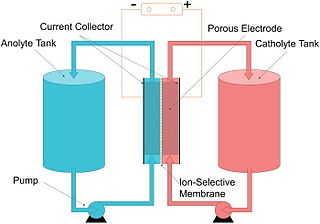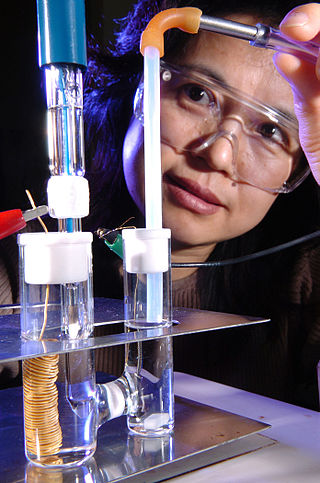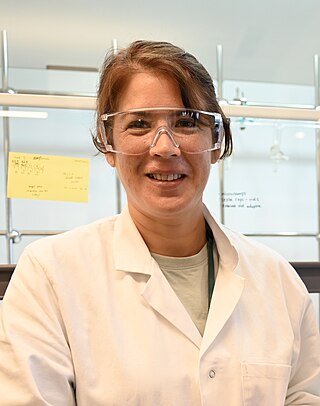Molecular electronics is the study and application of molecular building blocks for the fabrication of electronic components. It is an interdisciplinary area that spans physics, chemistry, and materials science. The unifying feature is use of molecular building blocks to fabricate electronic components. Due to the prospect of size reduction in electronics offered by molecular-level control of properties, molecular electronics has generated much excitement. It provides a potential means to extend Moore's Law beyond the foreseen limits of small-scale conventional silicon integrated circuits.

A dye-sensitized solar cell is a low-cost solar cell belonging to the group of thin film solar cells. It is based on a semiconductor formed between a photo-sensitized anode and an electrolyte, a photoelectrochemical system. The modern version of a dye solar cell, also known as the Grätzel cell, was originally co-invented in 1988 by Brian O'Regan and Michael Grätzel at UC Berkeley and this work was later developed by the aforementioned scientists at the École Polytechnique Fédérale de Lausanne (EPFL) until the publication of the first high efficiency DSSC in 1991. Michael Grätzel has been awarded the 2010 Millennium Technology Prize for this invention.

A flow battery, or redox flow battery, is a type of electrochemical cell where chemical energy is provided by two chemical components dissolved in liquids that are pumped through the system on separate sides of a membrane. Ion transfer inside the cell occurs through the membrane while both liquids circulate in their own respective space. Cell voltage is chemically determined by the Nernst equation and ranges, in practical applications, from 1.0 to 2.43 volts. The energy capacity is a function of the electrolyte volume and the power is a function of the surface area of the electrodes.

Buckypaper is a thin sheet made from an aggregate of carbon nanotubes or carbon nanotube grid paper. The nanotubes are approximately 50,000 times thinner than a human hair. Originally, it was fabricated as a way to handle carbon nanotubes, but it is also being studied and developed into applications by several research groups, showing promise as vehicle armor, personal armor, and next-generation electronics and displays.
A polymer-based battery uses organic materials instead of bulk metals to form a battery. Currently accepted metal-based batteries pose many challenges due to limited resources, negative environmental impact, and the approaching limit of progress. Redox active polymers are attractive options for electrodes in batteries due to their synthetic availability, high-capacity, flexibility, light weight, low cost, and low toxicity. Recent studies have explored how to increase efficiency and reduce challenges to push polymeric active materials further towards practicality in batteries. Many types of polymers are being explored, including conductive, non-conductive, and radical polymers. Batteries with a combination of electrodes are easier to test and compare to current metal-based batteries, however batteries with both a polymer cathode and anode are also a current research focus. Polymer-based batteries, including metal/polymer electrode combinations, should be distinguished from metal-polymer batteries, such as a lithium polymer battery, which most often involve a polymeric electrolyte, as opposed to polymeric active materials.
Heinz Gerischer was a German chemist who specialized in electrochemistry. He was the thesis advisor of future Nobel laureate Gerhard Ertl.
The programmable metallization cell, or PMC, is a non-volatile computer memory developed at Arizona State University. PMC, a technology developed to replace the widely used flash memory, providing a combination of longer lifetimes, lower power, and better memory density. Infineon Technologies, who licensed the technology in 2004, refers to it as conductive-bridging RAM, or CBRAM. CBRAM became a registered trademark of Adesto Technologies in 2011. NEC has a variant called "Nanobridge" and Sony calls their version "electrolytic memory".

An electrocatalyst is a catalyst that participates in electrochemical reactions. Electrocatalysts are a specific form of catalysts that function at electrode surfaces or, most commonly, may be the electrode surface itself. An electrocatalyst can be heterogeneous such as a platinized electrode. Homogeneous electrocatalysts, which are soluble, assist in transferring electrons between the electrode and reactants, and/or facilitate an intermediate chemical transformation described by an overall half reaction. Major challenges in electrocatalysts focus on fuel cells.

Rodney S. "Rod" Ruoff is an American physical chemist and nanoscience researcher. He is one of the world experts on carbon materials including carbon nanostructures such as fullerenes, nanotubes, graphene, diamond, and has had pioneering discoveries on such materials and others. Ruoff received his B.S. in chemistry from the University of Texas at Austin (1981) and his Ph.D. in chemical physics at the University of Illinois-Urbana (1988). After a Fulbright Fellowship at the MPI fuer Stroemungsforschung in Goettingen, Germany (1989) and postdoctoral work at the IBM T. J. Watson Research Center (1990–91), Ruoff became a staff scientist in the Molecular Physics Laboratory at SRI International (1991–1996). He is currently UNIST Distinguished Professor at the Ulsan National Institute of Science and Technology (UNIST), and the director of the Center for Multidimensional Carbon Materials, an Institute for Basic Science Center located at UNIST.
Scanning electrochemical microscopy (SECM) is a technique within the broader class of scanning probe microscopy (SPM) that is used to measure the local electrochemical behavior of liquid/solid, liquid/gas and liquid/liquid interfaces. Initial characterization of the technique was credited to University of Texas electrochemist, Allen J. Bard, in 1989. Since then, the theoretical underpinnings have matured to allow widespread use of the technique in chemistry, biology and materials science. Spatially resolved electrochemical signals can be acquired by measuring the current at an ultramicroelectrode (UME) tip as a function of precise tip position over a substrate region of interest. Interpretation of the SECM signal is based on the concept of diffusion-limited current. Two-dimensional raster scan information can be compiled to generate images of surface reactivity and chemical kinetics.
Julie Macpherson is a professor of chemistry at the University of Warwick. In 2017 she was awarded the Royal Society Innovation award for her research into boron doped diamond electrochemical sensors.
Serena Corr is a chair in Functional Materials and Professor in Chemical and Biological Engineering at the University of Sheffield. She works on next-generation battery materials and advanced characterisation techniques for nanomaterials.
Electro-oxidation(EO or EOx), also known as anodic oxidation or electrochemical oxidation (EC), is a technique used for wastewater treatment, mainly for industrial effluents, and is a type of advanced oxidation process (AOP). The most general layout comprises two electrodes, operating as anode and cathode, connected to a power source. When an energy input and sufficient supporting electrolyte are provided to the system, strong oxidizing species are formed, which interact with the contaminants and degrade them. The refractory compounds are thus converted into reaction intermediates and, ultimately, into water and CO2 by complete mineralization.
Gas-diffusion electrocrystallization (GDEx) is an electrochemical process consisting on the reactive precipitation of metal ions in solution with intermediaries produced by the electrochemical reduction of gases, at gas diffusion electrodes. It can serve for the recovery of metals or metalloids into solid precipitates or for the synthesis of libraries of nanoparticles.
Jingdong Zhang was a Chinese–Danish chemist and Professor of Chemistry at the Technical University of Denmark. Her research considered nanochemistry and the novel materials for catalysis, as well as the development of advanced characterisation techniques such as scanning tunnelling microscopy and atomic force microscopy. She was elected to the Akademiet for de Tekniske Videnskaber in 2017.

Christine Luscombe is a Japanese-British chemist who is a professor at the Okinawa Institute of Science and Technology. Her research investigates polymer chemistry, organic electronics, organic photovoltaics and the synthesis of novel materials for processable electronics. She serves on the editorial boards of Macromolecules, Advanced Functional Materials, the Annual Review of Materials Research and ACS Applied Materials & Interfaces.
Andrea Russell is an American chemist who is a professor at the University of Southampton. She is vice president of the International Society of Electrochemistry. Her research considers the use of spectroscopy to better understand the interface between electrodes and electrolytes.

Debbie Silvester is a British-Australian chemist who is a professor at Curtin University. Her research considers electrochemical processes and sensing. She has explored room-temperature ionic liquids. In 2021, she was awarded the Australian Academy of Science Le Fèvre Medal.
Teresa Pellegrino is an Italian chemist who is Professor of Chemistry at the Istituto Italiano di Tecnologia. Her research considers nanomaterials for biomedical applications. She was appointed Associate Editor of Nanoscale in 2022.
Kathryn Toghill is a British chemist who is Professor of Sustainable Electrochemistry at Lancaster University. Her research considers the development of low-cost energy storage systems, with a particular focus on redox flow batteries.






